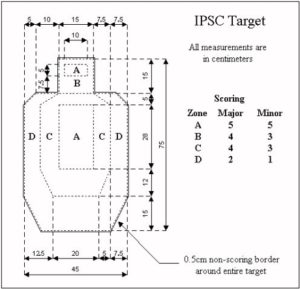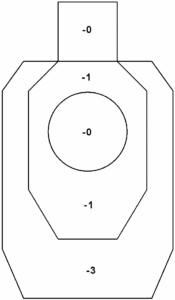In this article we are going to break down IDPA and USPSA, not to figure out which one is better, but to just break down and figure out which is which. Hopefully by the end you (the reader) and me (the writer) will have a better understanding of which one we (both of us) think will suit our shooting style. Granted I (the writer) shoot both (sorta, shoot is a strong word for the actions that I do during a match). Without further adue, here is what we got.
General Breakdown
IDPA: “Defensive Shooting” orientated. This means that the stages will be more centered on to “actual” situations you might encounter. The load out for gun and rounds carried on person is low, representing what one might have on them during a real life encounter.
USPSA: “Competition Shooting” Stages aren’t meant to represent real life scenarios. They are more centered around technical shooting. Stages are generally longer, and require more shots than an IDPA match.
Important thing to remember, these are both “games”. If you are competing against someone else and receiving a score it’s a GAME. Saying one is more tactically correct than the other is missing the point. Both have their own specific set of rules in order to shoot them correctly. Copping one out because one isn’t “real life” and another is “spray and pray” is a bush league weak sauce excuse to “I don’t want to follow the rules” mentality.
Safety
Same, IDPA and USPSA both require eye and ear protection. You will get disqualified just as fast in both if you do things like, but not limited to: flagging people with your gun, breaking the imaginary 180* line of you not keeping your gun down range, running with your finger on the trigger, and generally not being safe with a firearm.
Equipment
This is where things get kinda confusing. To put things simply neither is better than the other and you can shoot your regular gun in both. IDPA and USPSA have classes that cover everyone. You can totally bring your stock pistol to both and be competitive. Granted, if you have tweaked your gun too much you can either be at an advantage or disadvantage because you will be shooting “crippled” in a higher class, or you will be at the top of modification in a lower class. In neither organization have I felt that I have done the automotive equivalent of entering a vw bug in a formula 1 race.
USPSA:
Competition related. There are several divisions in the USPSA ranging from the Open division “Race Guns” to the box-stock “Production” guns.
The Open division is the premiere division, and as the name implies, there are not a lot of rules on what is legal and what is not. This is the division for Race Guns and you will never see one that isn’t compensated, modified, and sporting optical sights.
The Limited division is one step down as far as performance goes. Firearms cannot use compensators or optical sights, however certain modifications are allowed.
The Limited 10 division is similar to the Limited division, however shooters are limited to 10-round magazines. Some other modifications, basically the same as the Limited division, are allowed but optical sights and compensators are not.
Magazines, except for the Limited, Production, and Limited 10 divisions, are limited to 170mm and can hold as many rounds as you can stuff in them. The Limited division magazines are limited to 140mm unless they are “Single Stack” which may then extend to 170mm.
The Production division is for “Stock” guns and equipment. There are numerous limitations on what can and cannot be done to the firearm (more limits on what can NOT be done to it than what can be done to it), and it is designed for stock, unmodified guns and equipment.
USPSA also has a revolver division. There are limitations to what modifications may be performed. Compensators and optical sights are not allowed.
USPSA also provides for two “Power Factors” in most of the divisions; Major and Minor. Major power factor has a higher value placed on certain parts of the target under the assumption that someone shooting a more powerful gun deserves a break. The Production division does not distinguish between Major and Minor and all competitors are scored as Minor.
The “Power Factor” is calculated by multiplying the bullet weight by the muzzle velocity, then dividing by 1000. The break point between Major and Minor is 165; 165 or greater is Major and less than 165 is Minor. All firearms must have a minimum power factor of 125 for USPSA competition, and virtually anything of 9mm Luger or greater caliber will fit into Minor.
IDPA:

Defensive related. Everything about IDPA is related toward defensive pistol shooting. There are several divisions in IDPA that are determined by a particular firearm, however ALL divisions strictly limit what can be done to the firearm. In general, there are no major competition modifications allowed.
Magazines, depending on the division, are limited to 10 rounds or less. SSP is 10 rounds, ESP is 10 rounds, CDP is 8 rounds, and SSR is 6 rounds.
The IDPA divisions are SSP (Stock Service Pistol for most of the pistols of 9mm to .40 caliber), ESP (Enhanced Service Pistol for the single-action or selective SA/DA guns), CDP (Custom Defensive Pistol for the “Big Bore” shooters of 10mm, . 400 Cor-Bon, or .45 ACP), and SSR (Stock Service Revolver for the Wheel Guns).
Holsters, belts, and magazine pouches are also limited. “Speed” holsters and equipment are not allowed, and all equipment used must be on the IDPA “Approved” list.
IDPA also has a “Power Factor”, and it is calculated by multiplying the bullet weight by the muzzle velocity, however there is no scoring distinction between “Major” and “Minor” as in USPSA. A particular IDPA division has a minimum power factor, and the firearm must meet this minimum to be legal for competition. The minimum power factor is 125,000 (the same as a USPSA power factor of 125) for all divisions except CDP where the power factor is 165,000.
Classifications
USPSA:
Each time you shoot a match at a sanctioned club event, one of the stages will be a standard USPSA “Classifier”. Your score on this stage is sent to the USPSA by the club. The score is then compared to the best scores that USPSA has on file for that stage. After at least 4 scores have been submitted to USPSA you will receive a classification. Thereafter the best 6 of your most recent 8 classifications will be used to calculate your classification. The classification breakdowns are:
| D Class | Below 40.0% |
| C Class | 40.0% to 59.9% |
| B Class | 60.0% to 74.9% |
| A Class | 75.0% to 84.9% |
| Master Class | 85.0% to 94.9% |
| Grand Master Class | 95.0 % or above |
IDPA:
Classification of shooters is handled at the club level, and are separate for each IDPA division (SSP, ESP, CDP, and SSR). You receive a classification by shooting a standard classifier course-of-fire at an IDPA sanctioned club. The “Classifier” is exactly 90 rounds (no more, no less), and covers everything from close-in shooting (3 yards) to long-range shooting (20 yards) using free-style (both hands), strong hand only, and weak hand only. The time it takes you to shoot the course (plus any applicable penalties and scoring) determines your classification. The classification breakdowns are as follows:
| SSP | Novice | 210.01 or more | |
| Marksman | 210.00 to 152.74 | ||
| Sharpshooter | 152.73 to 120.01 | ||
| Expert | 120.00 to 98.83 | ||
| Master | 98.82 or less | ||
| ESP | Novice | 190.01 or more | |
| Marksman | 190.00 to 138.19 | ||
| Sharpshooter | 138.81 to 108.58 | ||
| Expert | 108.57 to 89.42 | ||
| Master | 89.41 or less | ||
| CDP | Novice | 195.01 or more | |
| Marksman | 195.00 to 141.83 | ||
| Sharpshooter | 141.82 to 111.44 | ||
| Expert | 111.43 to 91.77 | ||
| Master | 91.76 or less | ||
| SSR | Novice | 217.51 or more | |
| Marksman | 217.50 to 158.19 | ||
| Sharpshooter | 158.18 to 124.30 | ||
| Expert | 124.29 to 102.36 | ||
| Master | 102.35 or less |
IDPA classifications go into effect immediately after completing the classifier course of fire. An official of the club will sign your score card, and the classification is done.
Shooting The Stage
Strap on your belts, here we are gonna get into the actual shooting part. Now, I’m gonna do my best to break down to you how the stages are set up, and how you shoot them. I have compeated in National IDPA and Regional USPSA matches, I will be the first one to tell you that the stages are subject to change at a moments notice. The rules of the STAGE often are different from the GENERAL GUIDELINES written here. This being said here is the commonly accepted thought of how the stages are USUALLY run.
USPSA: Centers on competition. Courses are freely designed. Far and close targets are common. Targets are generally shot in order of presentation to the shooter.
Reloading, if you take more than 3 steps reload. Drop a mag with rounds still in it? Who cares?
Speed is usually a key to shooting the stages.
Cover, there are walls or barrels generally. They don’t normally have to be used as actual “cover”. Granted in a stage there might be a rule that you have to be behind a barrel when shooting, and that’s the only time where you will see cover actually being used
IDPA: Centers on “real life” scenarios. Stages are generaly broken down into “strings”. Strings are usually 6 shots long. This helps people that shoot revolvers. Targets range from close to far, can be steel or paper.
Reloading, reloads are normally done as needed, or in between “Strings”. Unlike USPSA, you cannot normally just dump a magazine on the ground though. There are three types of reloads in IDPA competition; Tactical Reload, Reload With Retention, and Reload From Slide Lock. The only time you can dump an empty magazine on the ground is when it is empty; if it is not empty you MUST hang onto it. The philosophy behind this is that if you were in a shooting situation on the street, you would NEVER throw away a magazine that still had ammunition in it.
Unlike USPSA, there are normally rules regarding which target is shot first. Again, this is because of the defensive nature of IDPA. If you were in a real-life shooting situation you would always try to be aware of which target posed the greatest threat. If you are not behind cover, the target that is closest to you poses the greatest threat and must be neutralized first. If the targets are equal distance from you, you will fire one shot at each and then go back and fire a second shot at each target. If you are behind cover, you would begin to expose yourself and shoot the targets as they become visible. You would never just jump out and start shooting because you would be exposing yourself to the other threats, so you must engage targets in sequence as they become visible.
Cover, cover is ALWAYS used in IDPA. 50% of your body needs to be behind cover if it is available. You will be penalized if you are not using cover correctly. If you are reloading, you will be reloading BEHIND cover. Nobody wants to reload without some form of cover or concealment if they can help it.
Scoring
I’m gonna put some pictures into this here with the target zones on actual targets. I find this stuff to be kind of confusing so I’m sure you will too.


USPSA
Paper targets are divided into an “A”, “B”, “C” and “D” zone. The value for each zone depends on the Power Factor of the gun. The values are:
| Zone | Major | Minor |
| A | 5 | 5 |
| B | 4 | 3 |
| C | 4 | 3 |
| D | 2 | 1 |
Points for steel targets that fall over or otherwise disappear when hit will be specified in the course description.
The total number of points for a stage, based on the target scores, is divided by a shooter’s time to shoot the stage to calculate a “Hit Factor” for the stage for each shooter. The shooter with the highest Hit Factor is given the maximum number of points available for the stage (i.e if the total number of target points on a stage is 60, the shooter with the highest Hit Factor will receive 60.0000 for that stage). The score for all other shooters is calculated based on the ratio of their hit factor to that of the stage winner (i.e. if the stage winner has a hit factor of 6.0000 and your hit factor is 3.0000 then the ratio of your hit factor to the winner’s hit factor is 0.5000. If the maximum score for the stage is 60.0000, the stage winner will get 60.0000 points for the stage and you will get 60.0000 x 0.5000, or 30.0000 points for the stage).
There are always penalties for certain infractions, and these are subtracted from your points.
IDPA:
Scoring is a bit simpler. The targets are divided into zones as in USPSA/IPSC, however the zones denote “Points Down”. The target has a Zero zone (denoting zero points down), a One zone (denoting one point down), and a Three zone (Denoting three points down). A miss is 5 points down. “Points Down” equate to one half of a second, thus if your shot is “Zero Points Down” no time is added to your time for the stage. A shot that is one point down will cause one half second to be added to your score, a shot that is 3 points down will cause 1 and a half seconds to be added, and a miss will cause two and a half seconds to be added. The time required for you to shoot a stage, and your “Points Down” (as well as any appropriate penalties) is added together for your stage score. The shooter in your division and classification with the lowest total time is the winner.
Summary
Now that we have broken both IDPA and USPSA to their bare structure in an unbiased look, hopefully you will be able to figure out which one you like more. In some ways IDPA and USPSA are the same, and stage by stage you could see crossovers between them. For more information hop on their respective website, visit their forums, and decide for yourself. Now that we have that out of the way, we’ll tackle the 9 and 45 debate…….


